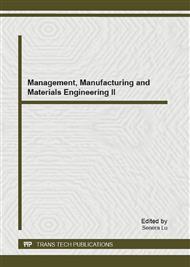[1]
Arbeitsgemeinschaft Energiebilanzen, Bundesverband der Energie-und Wasserwirtschaft- Projektgruppe Nutzenergiebilazen, (2009).
Google Scholar
[2]
R. Neugebauer, C. Hochmuth, G. Schmidt and M. Dix: Energy Efficient Process Planning Based on Numerical Simulations. Advanced Materials Research, Vol. 223(2011), pp.212-221.
DOI: 10.4028/www.scientific.net/amr.223.212
Google Scholar
[3]
Z.G. Jiang: Manufacturing Production Processes, Resources and Environmental Properties and Targets Integrated Decision-making Method. Unpublished PhD dissertation, Wuhan University of Science and Technology, (2007).
Google Scholar
[4]
LI Guowei, ZHANG Weimin and SUN Qun: Development Prospect of NC Machine Tool Based on High Energy-efficient Manufacturing. Manufacturing Technology & Machine Tool, Vol. 1 (2011), pp.47-49.
Google Scholar
[5]
T. Gutowski, C. Murphy, D. Alen, et, al.: Environmentally Benign Manufacturing: Observations from Japan, Europe and the United States. Journal of Cleaner Production, Vol. 13 (2005), pp.1-17.
DOI: 10.1016/j.jclepro.2003.10.004
Google Scholar
[6]
SUN Qun, ZHANG Weimin: Carbon Footprint Based Multilevel Hierarchical Production Process Control, China Mechanical Engineering, Vol. 22 (2011): pp.1035-1038, 1111.
Google Scholar
[7]
T. Wiedmann, J. Minx, in: Ecological Economics Research Trends, edited by Carolyn C. Pertsova Publications, Hauppauge, NY(2008), in press.
Google Scholar
[8]
S. Tridech, K. Cheng: Low Carbon Manufacturing: Characterization, Theoretical Models and Implementation. International Journal of Manufacturing Research, Vol. 6, number2 (2011), pp.110-121.
DOI: 10.1504/ijmr.2011.040006
Google Scholar
[9]
A. Dietmair, A. Verl: Energy Consumption Forecasting and Optimization for Tool Machines. Modern Machinery Science Journal, Vol. 3(2009), pp.62-67.
Google Scholar


